Economics Essay: Classical vs. Neoclassical Capitalism Views
VerifiedAdded on 2023/06/11
|10
|2440
|178
Essay
AI Summary
This essay delves into the contrasting perspectives of classical and neoclassical economic schools of thought regarding capitalism. It defines capitalism as an economic system where private entities own the factors of production, driven by profit maximization within a free market. The essay explores the advantages and disadvantages of capitalism, highlighting its efficiency-driven nature versus its potential neglect of equity and societal welfare. It contrasts the classical view, emphasizing laissez-faire and the invisible hand, with the neoclassical view, which incorporates individual rationality and consumer perspectives. A case study of China's state-directed capitalism reveals a divergence from both classical and neoclassical ideals due to significant government intervention. The essay concludes that while both schools advocate for limited government regulation, China's economic model demonstrates a unique approach to capitalism.
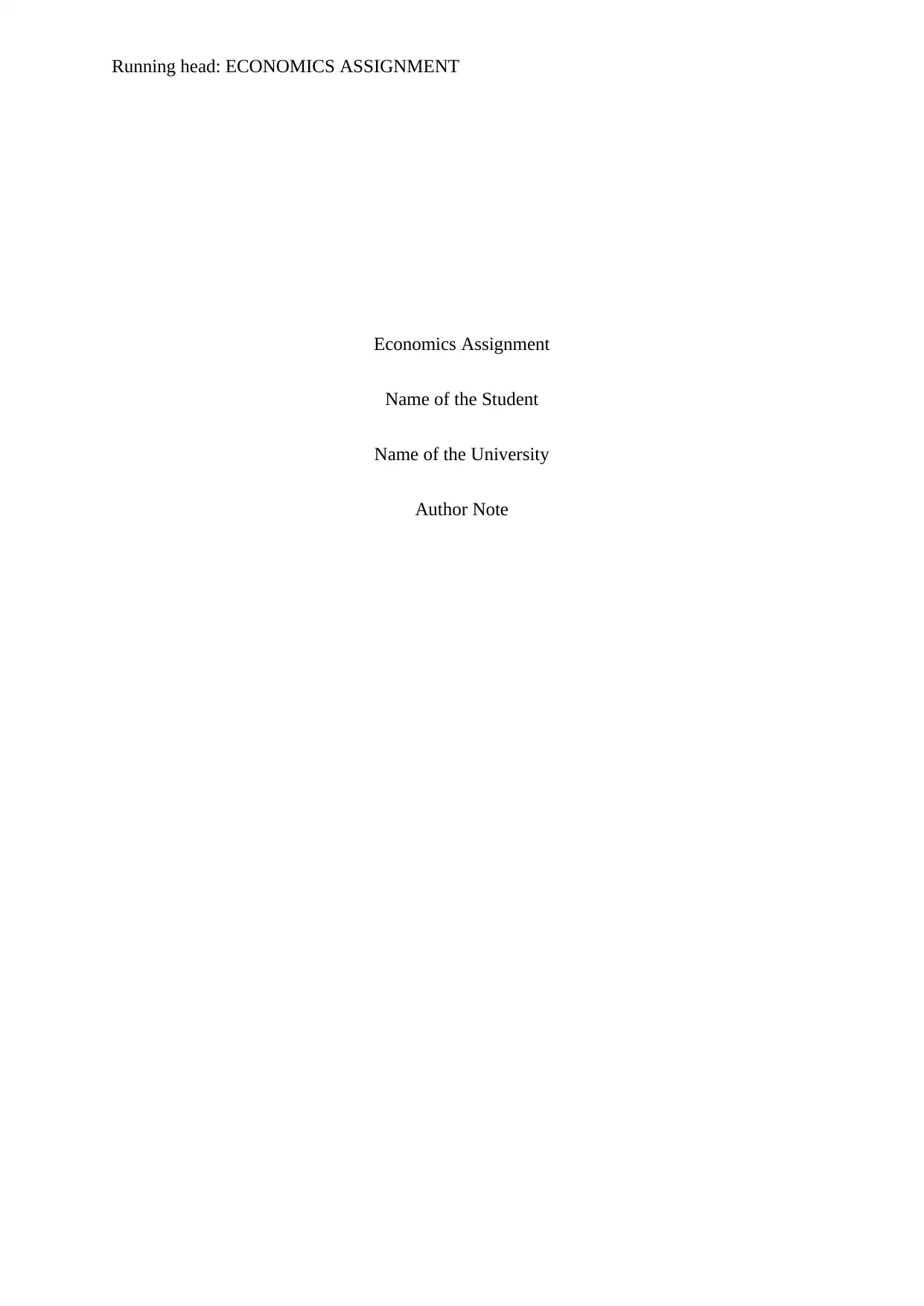
Running head: ECONOMICS ASSIGNMENT
Economics Assignment
Name of the Student
Name of the University
Author Note
Economics Assignment
Name of the Student
Name of the University
Author Note
Paraphrase This Document
Need a fresh take? Get an instant paraphrase of this document with our AI Paraphraser
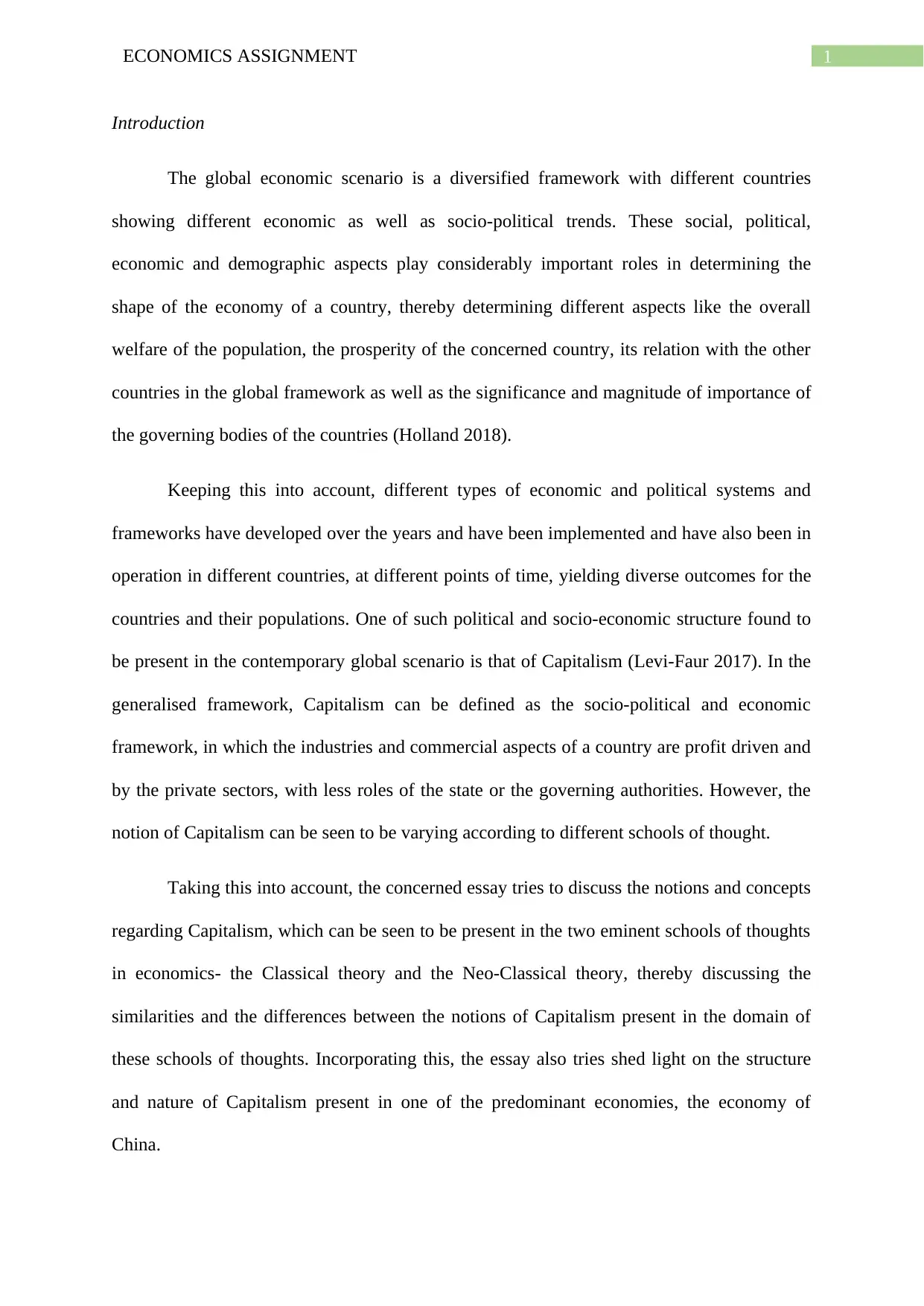
1ECONOMICS ASSIGNMENT
Introduction
The global economic scenario is a diversified framework with different countries
showing different economic as well as socio-political trends. These social, political,
economic and demographic aspects play considerably important roles in determining the
shape of the economy of a country, thereby determining different aspects like the overall
welfare of the population, the prosperity of the concerned country, its relation with the other
countries in the global framework as well as the significance and magnitude of importance of
the governing bodies of the countries (Holland 2018).
Keeping this into account, different types of economic and political systems and
frameworks have developed over the years and have been implemented and have also been in
operation in different countries, at different points of time, yielding diverse outcomes for the
countries and their populations. One of such political and socio-economic structure found to
be present in the contemporary global scenario is that of Capitalism (Levi-Faur 2017). In the
generalised framework, Capitalism can be defined as the socio-political and economic
framework, in which the industries and commercial aspects of a country are profit driven and
by the private sectors, with less roles of the state or the governing authorities. However, the
notion of Capitalism can be seen to be varying according to different schools of thought.
Taking this into account, the concerned essay tries to discuss the notions and concepts
regarding Capitalism, which can be seen to be present in the two eminent schools of thoughts
in economics- the Classical theory and the Neo-Classical theory, thereby discussing the
similarities and the differences between the notions of Capitalism present in the domain of
these schools of thoughts. Incorporating this, the essay also tries shed light on the structure
and nature of Capitalism present in one of the predominant economies, the economy of
China.
Introduction
The global economic scenario is a diversified framework with different countries
showing different economic as well as socio-political trends. These social, political,
economic and demographic aspects play considerably important roles in determining the
shape of the economy of a country, thereby determining different aspects like the overall
welfare of the population, the prosperity of the concerned country, its relation with the other
countries in the global framework as well as the significance and magnitude of importance of
the governing bodies of the countries (Holland 2018).
Keeping this into account, different types of economic and political systems and
frameworks have developed over the years and have been implemented and have also been in
operation in different countries, at different points of time, yielding diverse outcomes for the
countries and their populations. One of such political and socio-economic structure found to
be present in the contemporary global scenario is that of Capitalism (Levi-Faur 2017). In the
generalised framework, Capitalism can be defined as the socio-political and economic
framework, in which the industries and commercial aspects of a country are profit driven and
by the private sectors, with less roles of the state or the governing authorities. However, the
notion of Capitalism can be seen to be varying according to different schools of thought.
Taking this into account, the concerned essay tries to discuss the notions and concepts
regarding Capitalism, which can be seen to be present in the two eminent schools of thoughts
in economics- the Classical theory and the Neo-Classical theory, thereby discussing the
similarities and the differences between the notions of Capitalism present in the domain of
these schools of thoughts. Incorporating this, the essay also tries shed light on the structure
and nature of Capitalism present in one of the predominant economies, the economy of
China.
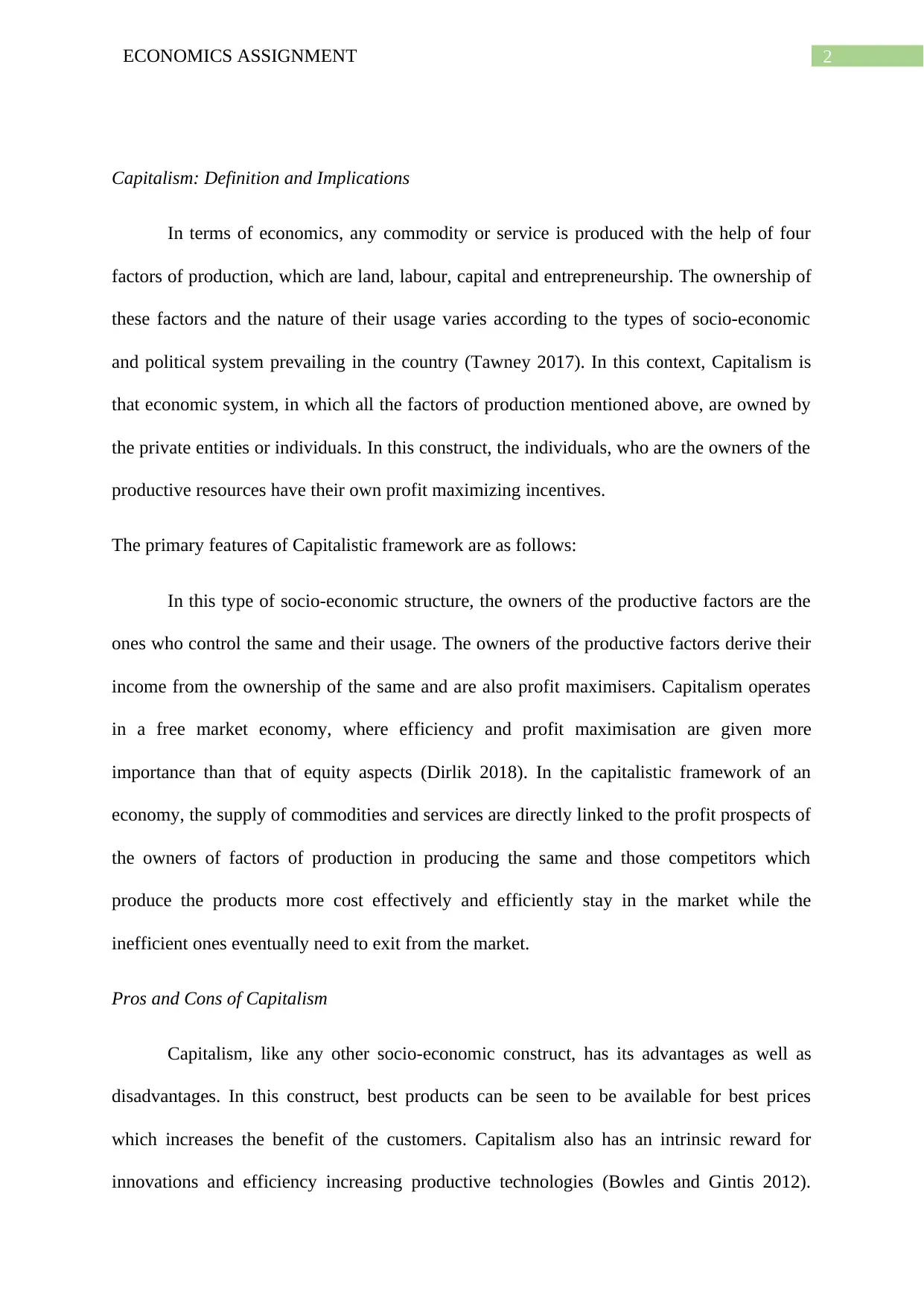
2ECONOMICS ASSIGNMENT
Capitalism: Definition and Implications
In terms of economics, any commodity or service is produced with the help of four
factors of production, which are land, labour, capital and entrepreneurship. The ownership of
these factors and the nature of their usage varies according to the types of socio-economic
and political system prevailing in the country (Tawney 2017). In this context, Capitalism is
that economic system, in which all the factors of production mentioned above, are owned by
the private entities or individuals. In this construct, the individuals, who are the owners of the
productive resources have their own profit maximizing incentives.
The primary features of Capitalistic framework are as follows:
In this type of socio-economic structure, the owners of the productive factors are the
ones who control the same and their usage. The owners of the productive factors derive their
income from the ownership of the same and are also profit maximisers. Capitalism operates
in a free market economy, where efficiency and profit maximisation are given more
importance than that of equity aspects (Dirlik 2018). In the capitalistic framework of an
economy, the supply of commodities and services are directly linked to the profit prospects of
the owners of factors of production in producing the same and those competitors which
produce the products more cost effectively and efficiently stay in the market while the
inefficient ones eventually need to exit from the market.
Pros and Cons of Capitalism
Capitalism, like any other socio-economic construct, has its advantages as well as
disadvantages. In this construct, best products can be seen to be available for best prices
which increases the benefit of the customers. Capitalism also has an intrinsic reward for
innovations and efficiency increasing productive technologies (Bowles and Gintis 2012).
Capitalism: Definition and Implications
In terms of economics, any commodity or service is produced with the help of four
factors of production, which are land, labour, capital and entrepreneurship. The ownership of
these factors and the nature of their usage varies according to the types of socio-economic
and political system prevailing in the country (Tawney 2017). In this context, Capitalism is
that economic system, in which all the factors of production mentioned above, are owned by
the private entities or individuals. In this construct, the individuals, who are the owners of the
productive resources have their own profit maximizing incentives.
The primary features of Capitalistic framework are as follows:
In this type of socio-economic structure, the owners of the productive factors are the
ones who control the same and their usage. The owners of the productive factors derive their
income from the ownership of the same and are also profit maximisers. Capitalism operates
in a free market economy, where efficiency and profit maximisation are given more
importance than that of equity aspects (Dirlik 2018). In the capitalistic framework of an
economy, the supply of commodities and services are directly linked to the profit prospects of
the owners of factors of production in producing the same and those competitors which
produce the products more cost effectively and efficiently stay in the market while the
inefficient ones eventually need to exit from the market.
Pros and Cons of Capitalism
Capitalism, like any other socio-economic construct, has its advantages as well as
disadvantages. In this construct, best products can be seen to be available for best prices
which increases the benefit of the customers. Capitalism also has an intrinsic reward for
innovations and efficiency increasing productive technologies (Bowles and Gintis 2012).
⊘ This is a preview!⊘
Do you want full access?
Subscribe today to unlock all pages.

Trusted by 1+ million students worldwide
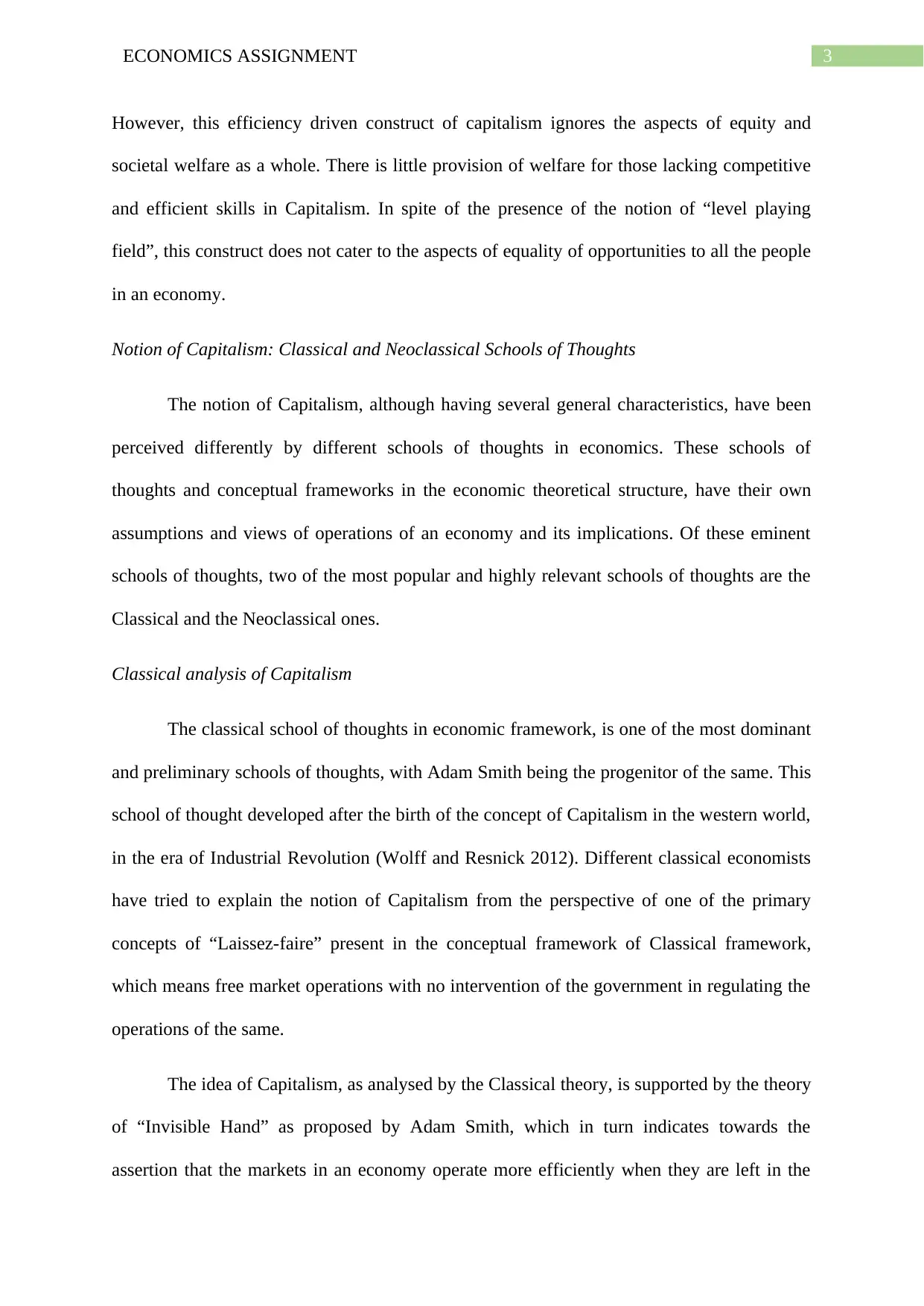
3ECONOMICS ASSIGNMENT
However, this efficiency driven construct of capitalism ignores the aspects of equity and
societal welfare as a whole. There is little provision of welfare for those lacking competitive
and efficient skills in Capitalism. In spite of the presence of the notion of “level playing
field”, this construct does not cater to the aspects of equality of opportunities to all the people
in an economy.
Notion of Capitalism: Classical and Neoclassical Schools of Thoughts
The notion of Capitalism, although having several general characteristics, have been
perceived differently by different schools of thoughts in economics. These schools of
thoughts and conceptual frameworks in the economic theoretical structure, have their own
assumptions and views of operations of an economy and its implications. Of these eminent
schools of thoughts, two of the most popular and highly relevant schools of thoughts are the
Classical and the Neoclassical ones.
Classical analysis of Capitalism
The classical school of thoughts in economic framework, is one of the most dominant
and preliminary schools of thoughts, with Adam Smith being the progenitor of the same. This
school of thought developed after the birth of the concept of Capitalism in the western world,
in the era of Industrial Revolution (Wolff and Resnick 2012). Different classical economists
have tried to explain the notion of Capitalism from the perspective of one of the primary
concepts of “Laissez-faire” present in the conceptual framework of Classical framework,
which means free market operations with no intervention of the government in regulating the
operations of the same.
The idea of Capitalism, as analysed by the Classical theory, is supported by the theory
of “Invisible Hand” as proposed by Adam Smith, which in turn indicates towards the
assertion that the markets in an economy operate more efficiently when they are left in the
However, this efficiency driven construct of capitalism ignores the aspects of equity and
societal welfare as a whole. There is little provision of welfare for those lacking competitive
and efficient skills in Capitalism. In spite of the presence of the notion of “level playing
field”, this construct does not cater to the aspects of equality of opportunities to all the people
in an economy.
Notion of Capitalism: Classical and Neoclassical Schools of Thoughts
The notion of Capitalism, although having several general characteristics, have been
perceived differently by different schools of thoughts in economics. These schools of
thoughts and conceptual frameworks in the economic theoretical structure, have their own
assumptions and views of operations of an economy and its implications. Of these eminent
schools of thoughts, two of the most popular and highly relevant schools of thoughts are the
Classical and the Neoclassical ones.
Classical analysis of Capitalism
The classical school of thoughts in economic framework, is one of the most dominant
and preliminary schools of thoughts, with Adam Smith being the progenitor of the same. This
school of thought developed after the birth of the concept of Capitalism in the western world,
in the era of Industrial Revolution (Wolff and Resnick 2012). Different classical economists
have tried to explain the notion of Capitalism from the perspective of one of the primary
concepts of “Laissez-faire” present in the conceptual framework of Classical framework,
which means free market operations with no intervention of the government in regulating the
operations of the same.
The idea of Capitalism, as analysed by the Classical theory, is supported by the theory
of “Invisible Hand” as proposed by Adam Smith, which in turn indicates towards the
assertion that the markets in an economy operate more efficiently when they are left in the
Paraphrase This Document
Need a fresh take? Get an instant paraphrase of this document with our AI Paraphraser
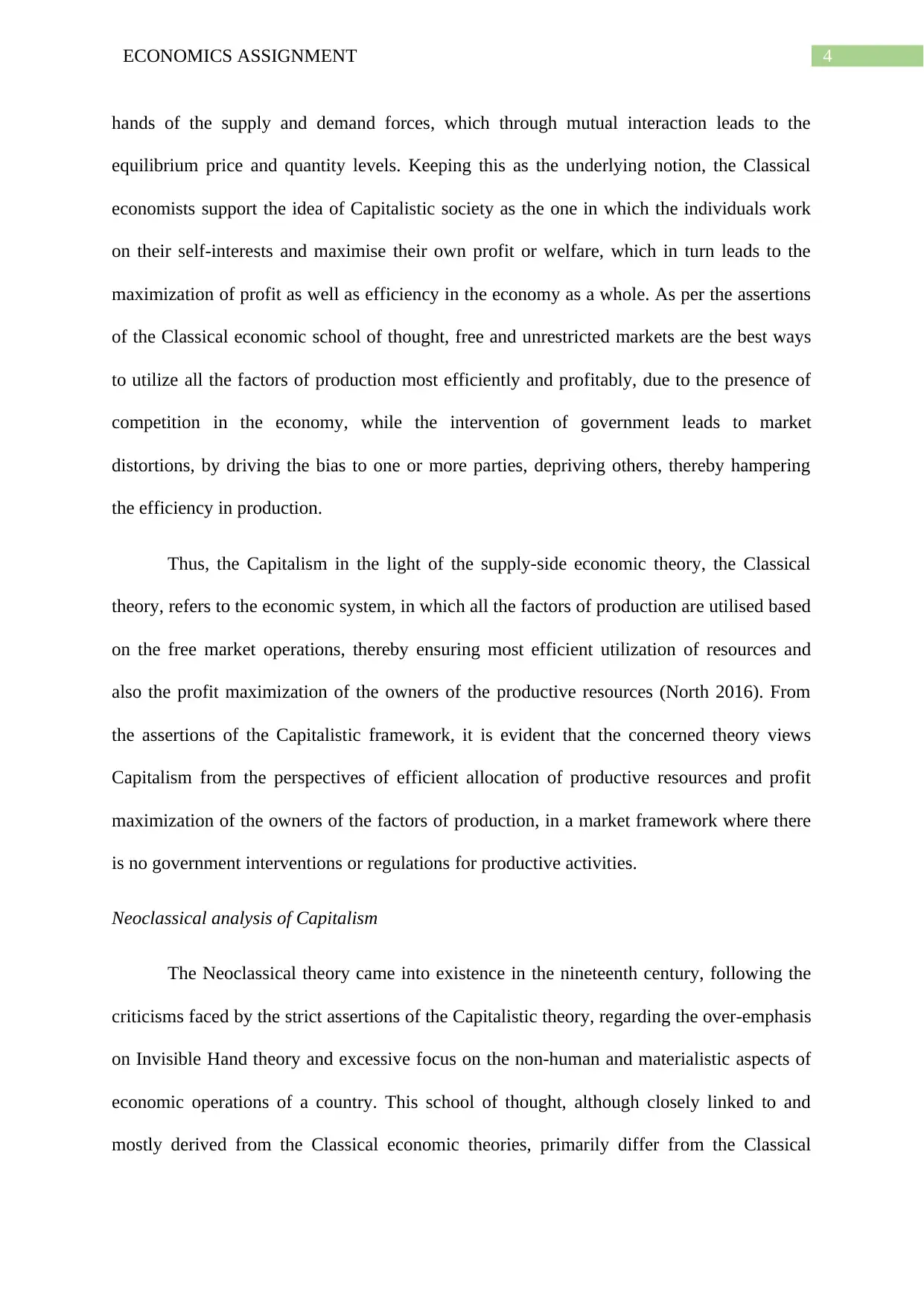
4ECONOMICS ASSIGNMENT
hands of the supply and demand forces, which through mutual interaction leads to the
equilibrium price and quantity levels. Keeping this as the underlying notion, the Classical
economists support the idea of Capitalistic society as the one in which the individuals work
on their self-interests and maximise their own profit or welfare, which in turn leads to the
maximization of profit as well as efficiency in the economy as a whole. As per the assertions
of the Classical economic school of thought, free and unrestricted markets are the best ways
to utilize all the factors of production most efficiently and profitably, due to the presence of
competition in the economy, while the intervention of government leads to market
distortions, by driving the bias to one or more parties, depriving others, thereby hampering
the efficiency in production.
Thus, the Capitalism in the light of the supply-side economic theory, the Classical
theory, refers to the economic system, in which all the factors of production are utilised based
on the free market operations, thereby ensuring most efficient utilization of resources and
also the profit maximization of the owners of the productive resources (North 2016). From
the assertions of the Capitalistic framework, it is evident that the concerned theory views
Capitalism from the perspectives of efficient allocation of productive resources and profit
maximization of the owners of the factors of production, in a market framework where there
is no government interventions or regulations for productive activities.
Neoclassical analysis of Capitalism
The Neoclassical theory came into existence in the nineteenth century, following the
criticisms faced by the strict assertions of the Capitalistic theory, regarding the over-emphasis
on Invisible Hand theory and excessive focus on the non-human and materialistic aspects of
economic operations of a country. This school of thought, although closely linked to and
mostly derived from the Classical economic theories, primarily differ from the Classical
hands of the supply and demand forces, which through mutual interaction leads to the
equilibrium price and quantity levels. Keeping this as the underlying notion, the Classical
economists support the idea of Capitalistic society as the one in which the individuals work
on their self-interests and maximise their own profit or welfare, which in turn leads to the
maximization of profit as well as efficiency in the economy as a whole. As per the assertions
of the Classical economic school of thought, free and unrestricted markets are the best ways
to utilize all the factors of production most efficiently and profitably, due to the presence of
competition in the economy, while the intervention of government leads to market
distortions, by driving the bias to one or more parties, depriving others, thereby hampering
the efficiency in production.
Thus, the Capitalism in the light of the supply-side economic theory, the Classical
theory, refers to the economic system, in which all the factors of production are utilised based
on the free market operations, thereby ensuring most efficient utilization of resources and
also the profit maximization of the owners of the productive resources (North 2016). From
the assertions of the Capitalistic framework, it is evident that the concerned theory views
Capitalism from the perspectives of efficient allocation of productive resources and profit
maximization of the owners of the factors of production, in a market framework where there
is no government interventions or regulations for productive activities.
Neoclassical analysis of Capitalism
The Neoclassical theory came into existence in the nineteenth century, following the
criticisms faced by the strict assertions of the Capitalistic theory, regarding the over-emphasis
on Invisible Hand theory and excessive focus on the non-human and materialistic aspects of
economic operations of a country. This school of thought, although closely linked to and
mostly derived from the Classical economic theories, primarily differ from the Classical
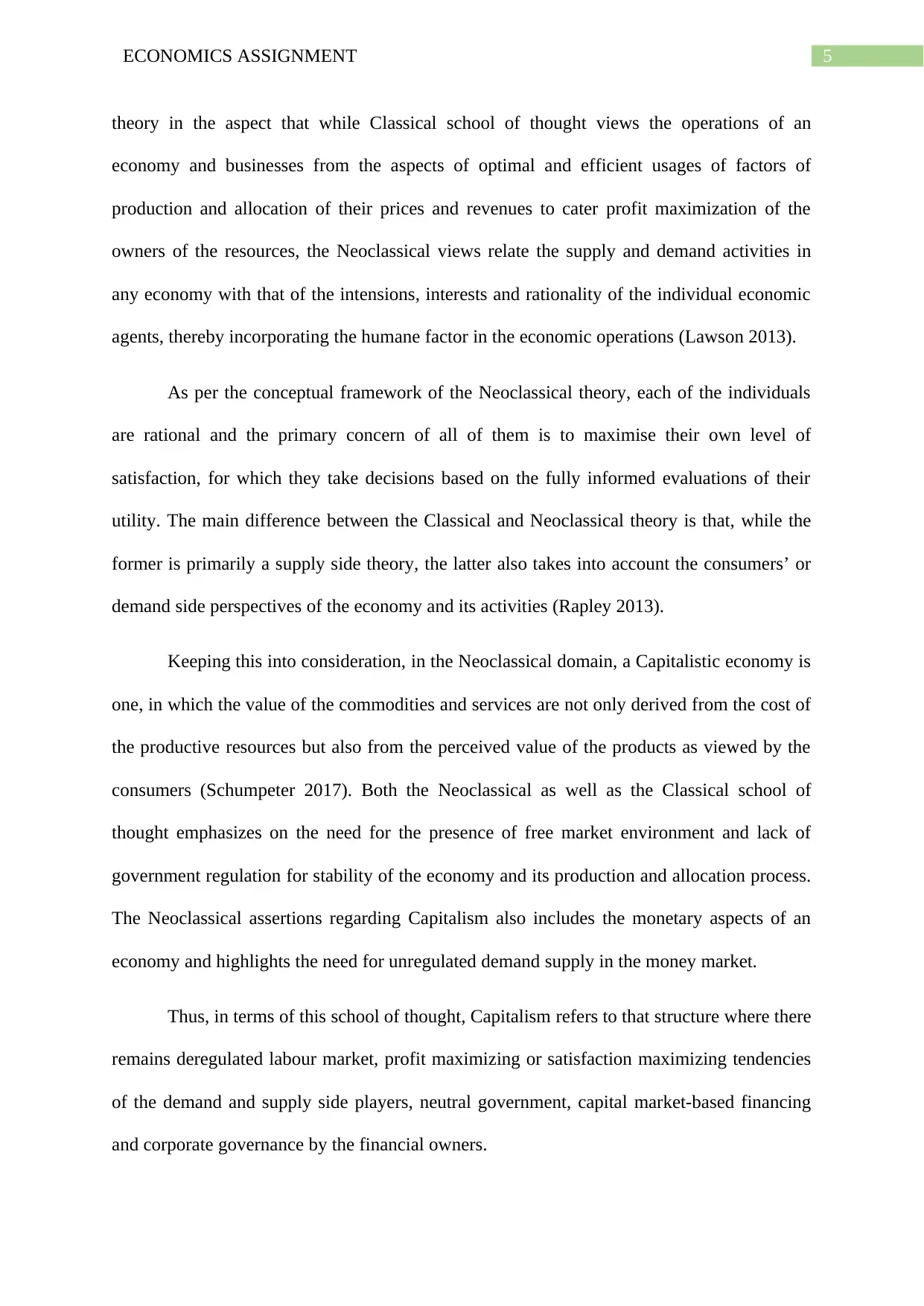
5ECONOMICS ASSIGNMENT
theory in the aspect that while Classical school of thought views the operations of an
economy and businesses from the aspects of optimal and efficient usages of factors of
production and allocation of their prices and revenues to cater profit maximization of the
owners of the resources, the Neoclassical views relate the supply and demand activities in
any economy with that of the intensions, interests and rationality of the individual economic
agents, thereby incorporating the humane factor in the economic operations (Lawson 2013).
As per the conceptual framework of the Neoclassical theory, each of the individuals
are rational and the primary concern of all of them is to maximise their own level of
satisfaction, for which they take decisions based on the fully informed evaluations of their
utility. The main difference between the Classical and Neoclassical theory is that, while the
former is primarily a supply side theory, the latter also takes into account the consumers’ or
demand side perspectives of the economy and its activities (Rapley 2013).
Keeping this into consideration, in the Neoclassical domain, a Capitalistic economy is
one, in which the value of the commodities and services are not only derived from the cost of
the productive resources but also from the perceived value of the products as viewed by the
consumers (Schumpeter 2017). Both the Neoclassical as well as the Classical school of
thought emphasizes on the need for the presence of free market environment and lack of
government regulation for stability of the economy and its production and allocation process.
The Neoclassical assertions regarding Capitalism also includes the monetary aspects of an
economy and highlights the need for unregulated demand supply in the money market.
Thus, in terms of this school of thought, Capitalism refers to that structure where there
remains deregulated labour market, profit maximizing or satisfaction maximizing tendencies
of the demand and supply side players, neutral government, capital market-based financing
and corporate governance by the financial owners.
theory in the aspect that while Classical school of thought views the operations of an
economy and businesses from the aspects of optimal and efficient usages of factors of
production and allocation of their prices and revenues to cater profit maximization of the
owners of the resources, the Neoclassical views relate the supply and demand activities in
any economy with that of the intensions, interests and rationality of the individual economic
agents, thereby incorporating the humane factor in the economic operations (Lawson 2013).
As per the conceptual framework of the Neoclassical theory, each of the individuals
are rational and the primary concern of all of them is to maximise their own level of
satisfaction, for which they take decisions based on the fully informed evaluations of their
utility. The main difference between the Classical and Neoclassical theory is that, while the
former is primarily a supply side theory, the latter also takes into account the consumers’ or
demand side perspectives of the economy and its activities (Rapley 2013).
Keeping this into consideration, in the Neoclassical domain, a Capitalistic economy is
one, in which the value of the commodities and services are not only derived from the cost of
the productive resources but also from the perceived value of the products as viewed by the
consumers (Schumpeter 2017). Both the Neoclassical as well as the Classical school of
thought emphasizes on the need for the presence of free market environment and lack of
government regulation for stability of the economy and its production and allocation process.
The Neoclassical assertions regarding Capitalism also includes the monetary aspects of an
economy and highlights the need for unregulated demand supply in the money market.
Thus, in terms of this school of thought, Capitalism refers to that structure where there
remains deregulated labour market, profit maximizing or satisfaction maximizing tendencies
of the demand and supply side players, neutral government, capital market-based financing
and corporate governance by the financial owners.
⊘ This is a preview!⊘
Do you want full access?
Subscribe today to unlock all pages.

Trusted by 1+ million students worldwide

6ECONOMICS ASSIGNMENT
Case Study of China
The economy of China, which used to be Communist economy in the previous years,
started shifting towards a more Capitalistic structure in the recent decades, as can be seen
from the opening up of the economy to foreign investors, increase in the number of private
and profit targeting businesses as well as a considerable increment in the size of the private
sector in the economy. From the 1980s, the economy of China started showing Capitalistic
traits, with increased privatisation and trade and investment dynamics both inwards and
outwards from the country, which in turn can be seen to have resulted in high economic
growths for the country (at an average of 10% growth rate in the economy from 1980s)
(Redding 2013).
However, the capitalistic traits in the country can be seen to be highly different from
the views of Classical school of thought in the aspects that while the theory asserts towards
the absence of any kind of intervention or regulation on part of the governing authorities of
the economies as a whole, the Capitalistic structure of China shows widely different traits
(Rattner 2018). The economy of the concerned country, shows the traits of a state-directed
Capitalism, in the recent periods, where the liberal environment of trade openness,
investment inflow and privatisation of the economy have been designed and implemented as
well as monitored to some extent by the government of the country in order to increase the
economic efficiency as well as welfare of the country (Dees 2017). Thus, the form of
Capitalism in China, can be seen to be different from the notions of both the Classical and
Neoclassical theories regarding the concept as there is significant presence of government
control in the capitalistic environment created in the country.
Conclusion
Case Study of China
The economy of China, which used to be Communist economy in the previous years,
started shifting towards a more Capitalistic structure in the recent decades, as can be seen
from the opening up of the economy to foreign investors, increase in the number of private
and profit targeting businesses as well as a considerable increment in the size of the private
sector in the economy. From the 1980s, the economy of China started showing Capitalistic
traits, with increased privatisation and trade and investment dynamics both inwards and
outwards from the country, which in turn can be seen to have resulted in high economic
growths for the country (at an average of 10% growth rate in the economy from 1980s)
(Redding 2013).
However, the capitalistic traits in the country can be seen to be highly different from
the views of Classical school of thought in the aspects that while the theory asserts towards
the absence of any kind of intervention or regulation on part of the governing authorities of
the economies as a whole, the Capitalistic structure of China shows widely different traits
(Rattner 2018). The economy of the concerned country, shows the traits of a state-directed
Capitalism, in the recent periods, where the liberal environment of trade openness,
investment inflow and privatisation of the economy have been designed and implemented as
well as monitored to some extent by the government of the country in order to increase the
economic efficiency as well as welfare of the country (Dees 2017). Thus, the form of
Capitalism in China, can be seen to be different from the notions of both the Classical and
Neoclassical theories regarding the concept as there is significant presence of government
control in the capitalistic environment created in the country.
Conclusion
Paraphrase This Document
Need a fresh take? Get an instant paraphrase of this document with our AI Paraphraser
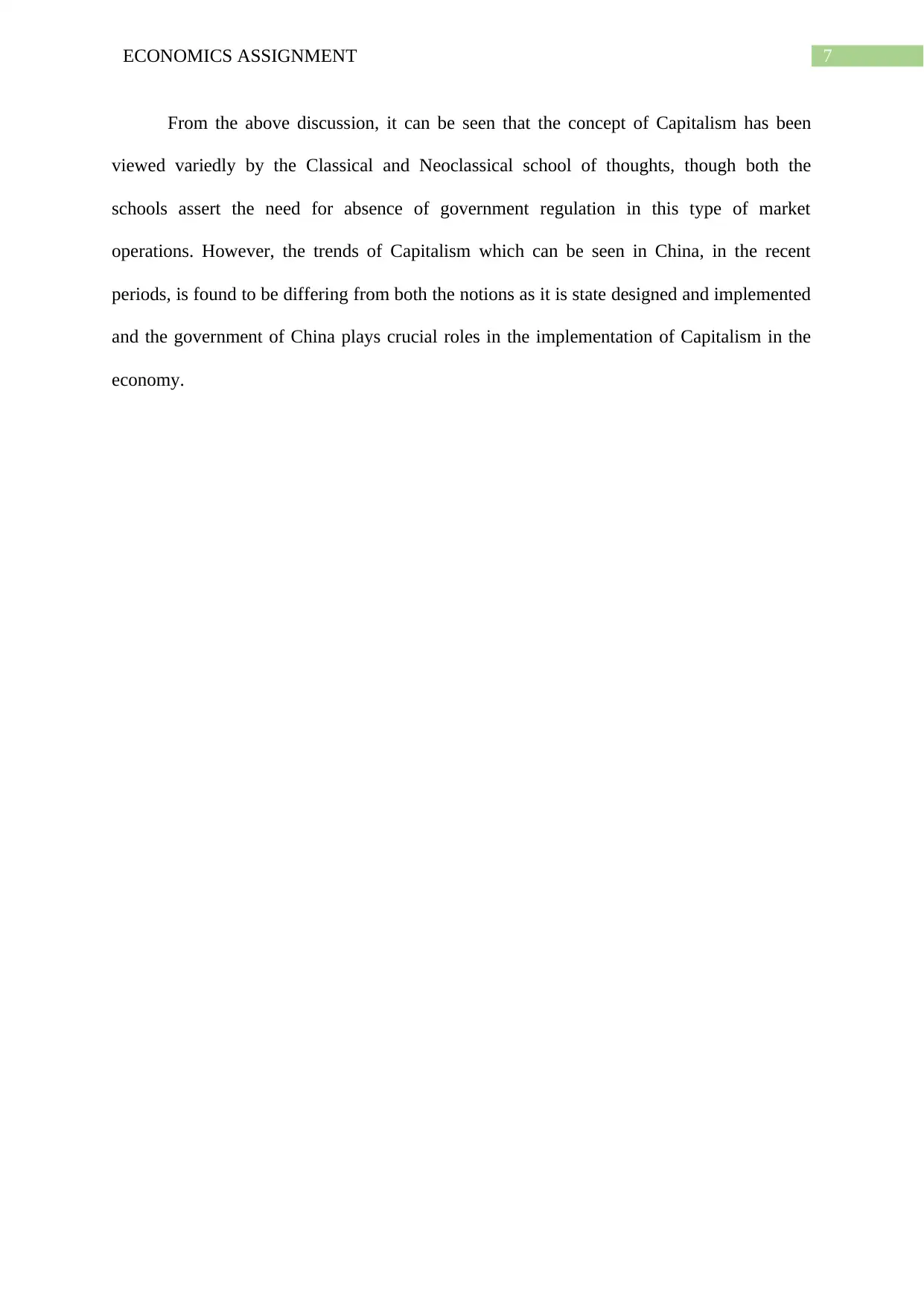
7ECONOMICS ASSIGNMENT
From the above discussion, it can be seen that the concept of Capitalism has been
viewed variedly by the Classical and Neoclassical school of thoughts, though both the
schools assert the need for absence of government regulation in this type of market
operations. However, the trends of Capitalism which can be seen in China, in the recent
periods, is found to be differing from both the notions as it is state designed and implemented
and the government of China plays crucial roles in the implementation of Capitalism in the
economy.
From the above discussion, it can be seen that the concept of Capitalism has been
viewed variedly by the Classical and Neoclassical school of thoughts, though both the
schools assert the need for absence of government regulation in this type of market
operations. However, the trends of Capitalism which can be seen in China, in the recent
periods, is found to be differing from both the notions as it is state designed and implemented
and the government of China plays crucial roles in the implementation of Capitalism in the
economy.
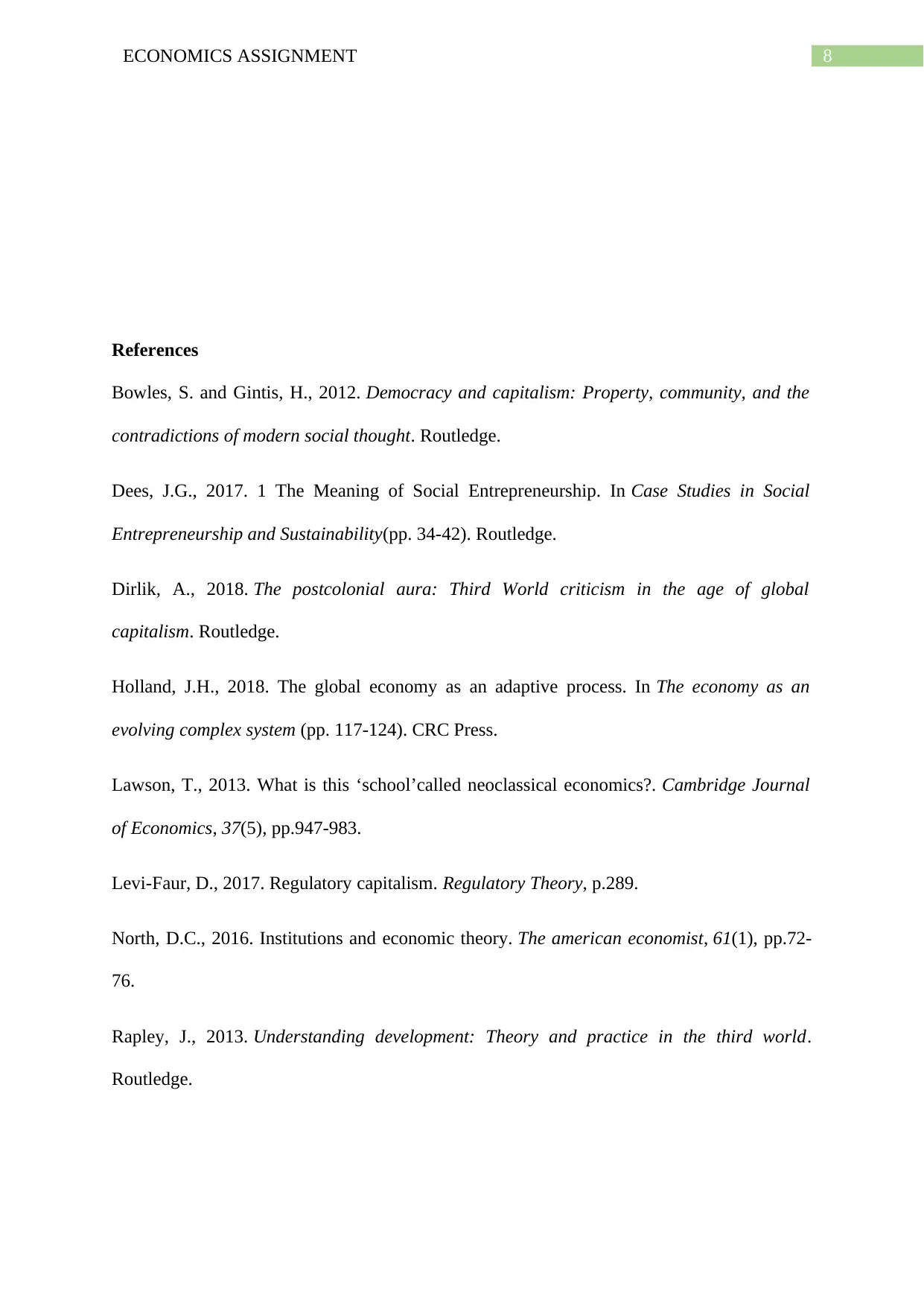
8ECONOMICS ASSIGNMENT
References
Bowles, S. and Gintis, H., 2012. Democracy and capitalism: Property, community, and the
contradictions of modern social thought. Routledge.
Dees, J.G., 2017. 1 The Meaning of Social Entrepreneurship. In Case Studies in Social
Entrepreneurship and Sustainability(pp. 34-42). Routledge.
Dirlik, A., 2018. The postcolonial aura: Third World criticism in the age of global
capitalism. Routledge.
Holland, J.H., 2018. The global economy as an adaptive process. In The economy as an
evolving complex system (pp. 117-124). CRC Press.
Lawson, T., 2013. What is this ‘school’called neoclassical economics?. Cambridge Journal
of Economics, 37(5), pp.947-983.
Levi-Faur, D., 2017. Regulatory capitalism. Regulatory Theory, p.289.
North, D.C., 2016. Institutions and economic theory. The american economist, 61(1), pp.72-
76.
Rapley, J., 2013. Understanding development: Theory and practice in the third world.
Routledge.
References
Bowles, S. and Gintis, H., 2012. Democracy and capitalism: Property, community, and the
contradictions of modern social thought. Routledge.
Dees, J.G., 2017. 1 The Meaning of Social Entrepreneurship. In Case Studies in Social
Entrepreneurship and Sustainability(pp. 34-42). Routledge.
Dirlik, A., 2018. The postcolonial aura: Third World criticism in the age of global
capitalism. Routledge.
Holland, J.H., 2018. The global economy as an adaptive process. In The economy as an
evolving complex system (pp. 117-124). CRC Press.
Lawson, T., 2013. What is this ‘school’called neoclassical economics?. Cambridge Journal
of Economics, 37(5), pp.947-983.
Levi-Faur, D., 2017. Regulatory capitalism. Regulatory Theory, p.289.
North, D.C., 2016. Institutions and economic theory. The american economist, 61(1), pp.72-
76.
Rapley, J., 2013. Understanding development: Theory and practice in the third world.
Routledge.
⊘ This is a preview!⊘
Do you want full access?
Subscribe today to unlock all pages.

Trusted by 1+ million students worldwide
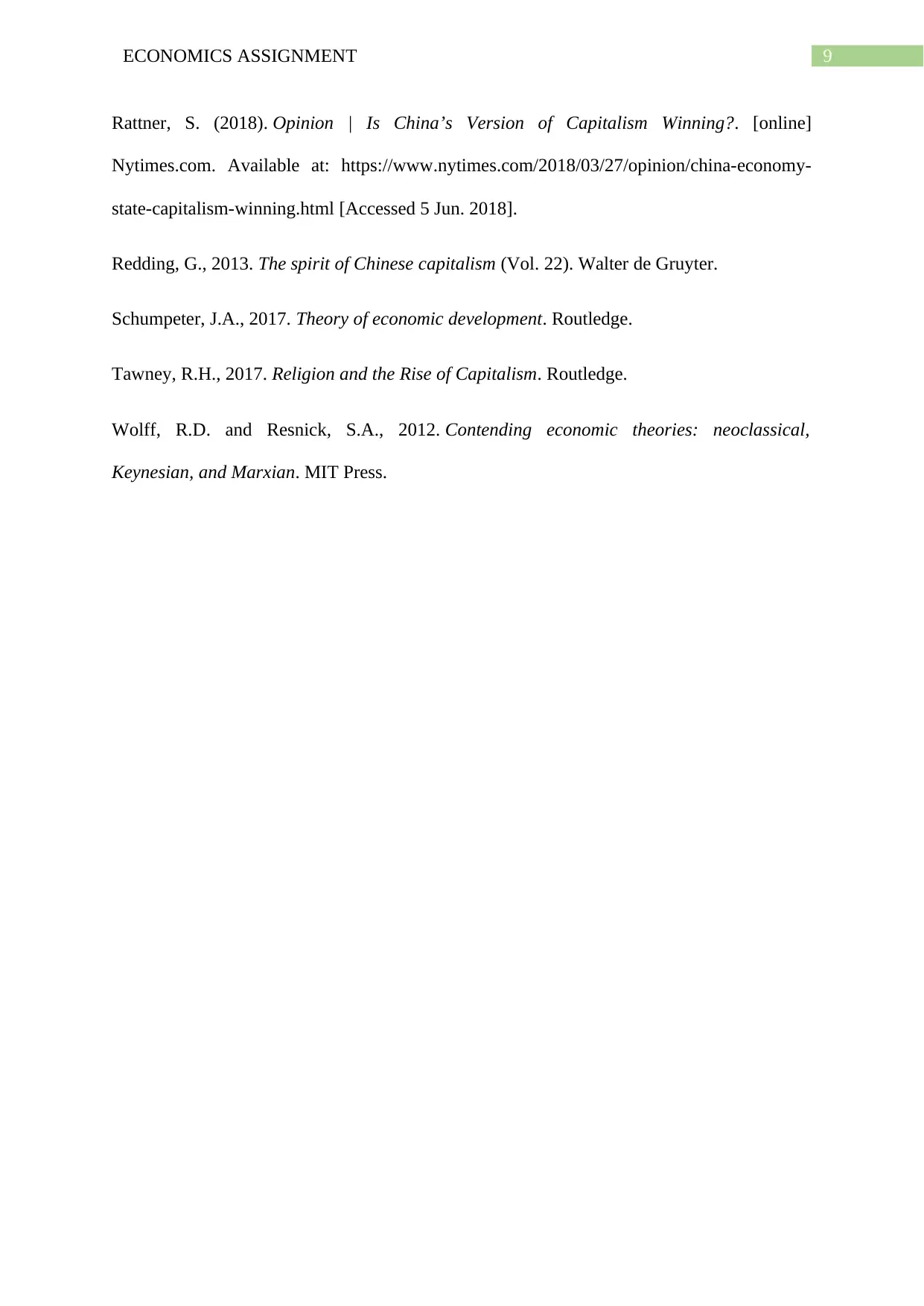
9ECONOMICS ASSIGNMENT
Rattner, S. (2018). Opinion | Is China’s Version of Capitalism Winning?. [online]
Nytimes.com. Available at: https://www.nytimes.com/2018/03/27/opinion/china-economy-
state-capitalism-winning.html [Accessed 5 Jun. 2018].
Redding, G., 2013. The spirit of Chinese capitalism (Vol. 22). Walter de Gruyter.
Schumpeter, J.A., 2017. Theory of economic development. Routledge.
Tawney, R.H., 2017. Religion and the Rise of Capitalism. Routledge.
Wolff, R.D. and Resnick, S.A., 2012. Contending economic theories: neoclassical,
Keynesian, and Marxian. MIT Press.
Rattner, S. (2018). Opinion | Is China’s Version of Capitalism Winning?. [online]
Nytimes.com. Available at: https://www.nytimes.com/2018/03/27/opinion/china-economy-
state-capitalism-winning.html [Accessed 5 Jun. 2018].
Redding, G., 2013. The spirit of Chinese capitalism (Vol. 22). Walter de Gruyter.
Schumpeter, J.A., 2017. Theory of economic development. Routledge.
Tawney, R.H., 2017. Religion and the Rise of Capitalism. Routledge.
Wolff, R.D. and Resnick, S.A., 2012. Contending economic theories: neoclassical,
Keynesian, and Marxian. MIT Press.
1 out of 10
Related Documents
Your All-in-One AI-Powered Toolkit for Academic Success.
+13062052269
info@desklib.com
Available 24*7 on WhatsApp / Email
![[object Object]](/_next/static/media/star-bottom.7253800d.svg)
Unlock your academic potential
Copyright © 2020–2025 A2Z Services. All Rights Reserved. Developed and managed by ZUCOL.





